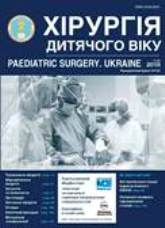Conservative treatment of longitudinal flat feet in children
DOI:
https://doi.org/10.15574/PS.2018.60.88Keywords:
longitudinal flatfoot, pain syndrome, children, serial castingAbstract
Longitudinal static flat feet in children (LSFFC) makes up to 58% of the total orthopaedic foot pathology. Conventional treatment and prevention methods do not provide a significant therapeutic effect and a steady, long-term result. This encourages the search for more efficient methods of conservative treatment of LSFFC of I-II grades.
Objective: to create the most efficient algorithm for conservative comprehensive treatment of LSFFC of I-II grade variations depending upon the results of the foot mobility, electromyographic parameters of muscular activity, radiological indices, and the severity of pain syndrome.
Materials and methods. The parameters obtained in the treatment of 31 patients aged from 6 to 16 years with LSFFC of I-II grades with pain syndrome were analysed. All patients were divided into three groups: group I (the control group) comprised 13 patients, group II (the main group) included 9 children, and in group III (the main group) 10 children were enrolled. The following clinical and instrumental methods of examination were used: interviewing, physical examination, X-ray, electromyography, assessment of the foot mobility degree and pain syndrome.
Results. The study of the clinical picture at the end of treatment showed a significant improvement in the condition of patients with longitudinal flat feet of the main group: a reduction of the main clinical symptoms of the disease, positive X-ray and electromyographic changes, normalization of the foot mobility.
Conclusions. Longitudinal flat feet in children is a complex pathology of the foot, which causes violation of locomotion, statics, contributes to the emergence of pain syndrome. Owing to the proposed method of conservative treatment, it is possible to reduce the progression of the pathology and to improve the patient’s quality of life.
References
Brodko TA. (1991). Surgical treatment of children’s congenital flat-valgus deformation of feet: author’s of abstract of dissertation of Candidate of Medical Science. Minsk: 19.
Gafarov Kh Z. (1995). Medical treatment of children and adolescents with orthopedic diseases of the lower limbs. Kazan : Tatar book publishing house: 384.
Liabakh AP. (2003). Clinical diagnosis of foot deformation. Kyiv: Closed Corporation Atlant UMC: 110. PMid:12918254
Martyniuk VU. (2000). Contemporary problems of rehabilitation in pediatric orthopedics : materials of research and practical conference. Annals of pediatric physiotherapy and health resort study. 3: 75–76.
Nickolaev LP. (1987). Nanual on biomechanics in application to orthopedics, traumatology and prosthesis. Kyiv: 315.
Sergienko KN. (2001). Assessment of informativity and efficiency of the methods used in the evaluation of the arches of a person’s foot. In Physical education of students of creative specialties. Collection of scientific works. Ermakov SS. (Ed.). Kharkiv: (KKPI). 6: 55–59.
Janson HA. (1976). Biomechanics of a person’s lower limb. Riga: Zenatne: 356.
Yaremenko DA. (1985). Diagnosis and classification of static deformation of feet. Orthopedics, traumatology and prosthesis.11: 59–67.
Davids JR, Valadie AL, Ferguson RL et al. (1997). Surgical management of ankle valgus sn children: us of a transphyseal medial malleolar screw. Journal of Pediatric Orthopaedics. 17: 3–8. https://doi.org/10.1097/00004694-199701000-00002; https://doi.org/10.1097/01241398-199701000-00002; PMid:8989691
Dennis R Wenger, Mercer Rang. (1993). The Art and Practice of children’s orthopedics. New York: Raven PRESS: 752.
Halliwell B, Gutteridge JMC. (1995). Free radicals in biology and medicin. Oxford: Clarendon Press: 385. https://doi.org/10.1016/0891-5849(95)91457-3
Wiltse LL. (1972, April). Valgus deformity of the ankle. The Journal of Bone and Joint Surgery. 54-A; 3: 595–606. https://doi.org/10.2106/00004623-197254030-00013
Downloads
Issue
Section
License
The policy of the Journal “PAEDIATRIC SURGERY. UKRAINE” is compatible with the vast majority of funders' of open access and self-archiving policies. The journal provides immediate open access route being convinced that everyone – not only scientists - can benefit from research results, and publishes articles exclusively under open access distribution, with a Creative Commons Attribution-Noncommercial 4.0 international license(СС BY-NC).
Authors transfer the copyright to the Journal “PAEDIATRIC SURGERY.UKRAINE” when the manuscript is accepted for publication. Authors declare that this manuscript has not been published nor is under simultaneous consideration for publication elsewhere. After publication, the articles become freely available on-line to the public.
Readers have the right to use, distribute, and reproduce articles in any medium, provided the articles and the journal are properly cited.
The use of published materials for commercial purposes is strongly prohibited.

